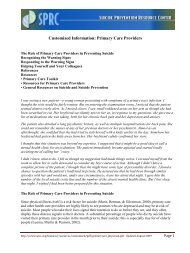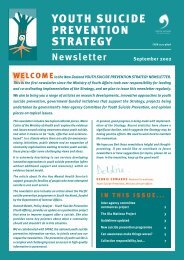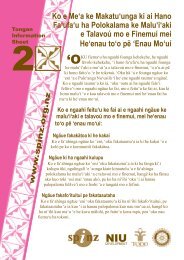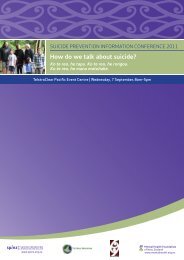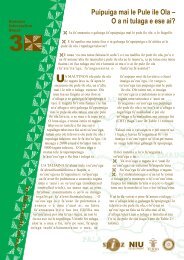A background document to support Kia Piki Te Ora O Te ... - SPINZ
A background document to support Kia Piki Te Ora O Te ... - SPINZ
A background document to support Kia Piki Te Ora O Te ... - SPINZ
You also want an ePaper? Increase the reach of your titles
YUMPU automatically turns print PDFs into web optimized ePapers that Google loves.
Above all, irrespective of a loss of consciousness and knowledge about whakapapa, Mäori youth do have<br />
whakapapa which potentially binds them <strong>to</strong> a caring Mäori community. However, that relationship is a<br />
reciprocal one. Mäori communities including Mäori youth must be instrumental in the realisation of Mäori<br />
youth potential and the strengthening of whakapapa as Mäori.<br />
Goal three: cultural development<br />
To increase the role of cultural (tikanga) development as a protective fac<strong>to</strong>r for taitamariki Māori<br />
This goal recognises that Mäori youth are unique as Mäori and that if the conditions could be recreated<br />
whereby the positive aspects of being Mäori were brought in<strong>to</strong> a contemporary setting, this may protect<br />
Mäori youth from some of the risk fac<strong>to</strong>rs for suicide. It is based on the belief that Mäori youth problems<br />
are partly a result of being alienated from cultural values and identity. It is also about the lack of rules for<br />
conduct that create a reciprocal responsibility for the maintenance and protection of whakapapa.<br />
As has already been discussed, cultural development can occur in the most colonised of indigenous<br />
populations, as the Alaskan community suicide prevention programmes demonstrate. However, it requires<br />
cultural experts who know how <strong>to</strong> combine cultural practices with contemporary realities.<br />
Goal four: <strong>support</strong> of mainstream<br />
To encourage and assist mainstream services<br />
<strong>to</strong> respond appropriately and effectively <strong>to</strong> the needs of taitamariki Māori<br />
The majority of Mäori youth receive mainstream services particularly through the education system. It is<br />
important <strong>to</strong> note that 25% of all Mäori suicides occur in a mainstream setting – in prisons. It is the view of<br />
the author that misdiagnosis of Mäori in the mental health services means that Mäori are the casualties of a<br />
mental health service that cannot cater for them.<br />
Therefore, it is imperative that mainstream services are encouraged <strong>to</strong> deliver a safe level of service <strong>to</strong> Mäori.<br />
This is <strong>to</strong> reduce the potential for mainstream services <strong>to</strong> create secondary victims of Mäori youth (that is,<br />
Mäori youth are victimised because they are Mäori and victimised a second time by mainstream services that<br />
fail them).<br />
It is also important <strong>to</strong> understand that what has been advocated in this strategy is a Mäori development<br />
approach. That will take time. However, in the meantime, and alongside Mäori development, mainstream<br />
development cannot be overlooked because of the fact that many Mäori interact, and will probably continue<br />
<strong>to</strong> do so, with the mental health services.<br />
Goal five: information and research<br />
To improve the understanding of the causes and the true level of suicide amongst taitamariki Māori<br />
In 1994 Disley noted that there was a lack of information about New Zealand youth suicide. 140 This is still<br />
relevant in 1997.<br />
There is almost no research or information about the causes and true level of Mäori youth suicide that can be<br />
used <strong>to</strong> inform prevention efforts. The way in which Mäori youth suicide statistics are collected is seriously<br />
deficient. It is debatable whether the collection of Mäori youth suicide statistics is an effective use of<br />
resources when the critical success fac<strong>to</strong>rs of Mäori health programmes may be a better way <strong>to</strong> programme<br />
for the prevention of Mäori youth suicide.<br />
A REVIEW OF EVIDENCE: KIA PIKI TE ORA O TE TAITAMARIKI – THE NEW ZEALAND YOUTH SUICIDE PREVENTION STRATEGY<br />
However, where decisions such as whether there is or is not a ‘real’ Mäori youth suicide problem are being<br />
made by comparison between Mäori and non-Mäori youth suicide data it becomes important <strong>to</strong> be able <strong>to</strong><br />
identify the deficiencies in current data collection processes for Mäori. Further, anecdotal reports suggest that<br />
the number of Mäori youth suicides is significantly higher than officially reported suicide statistics. These<br />
PAGE 33



